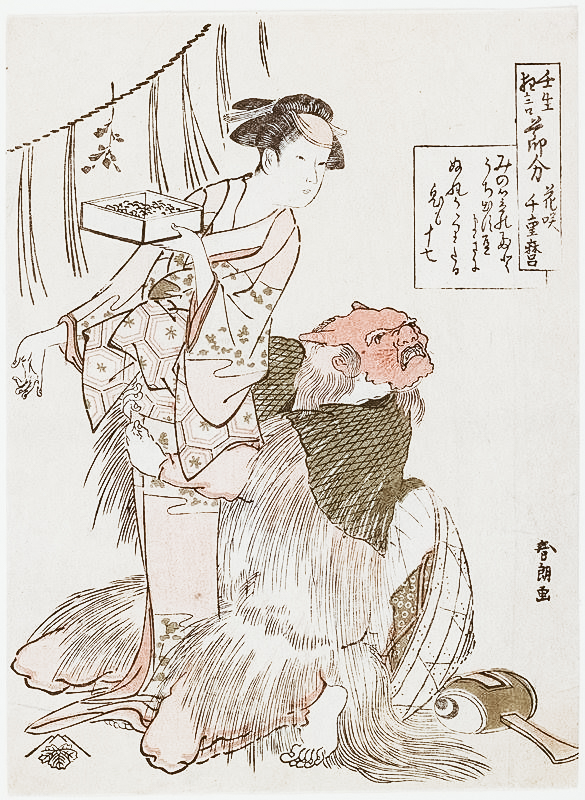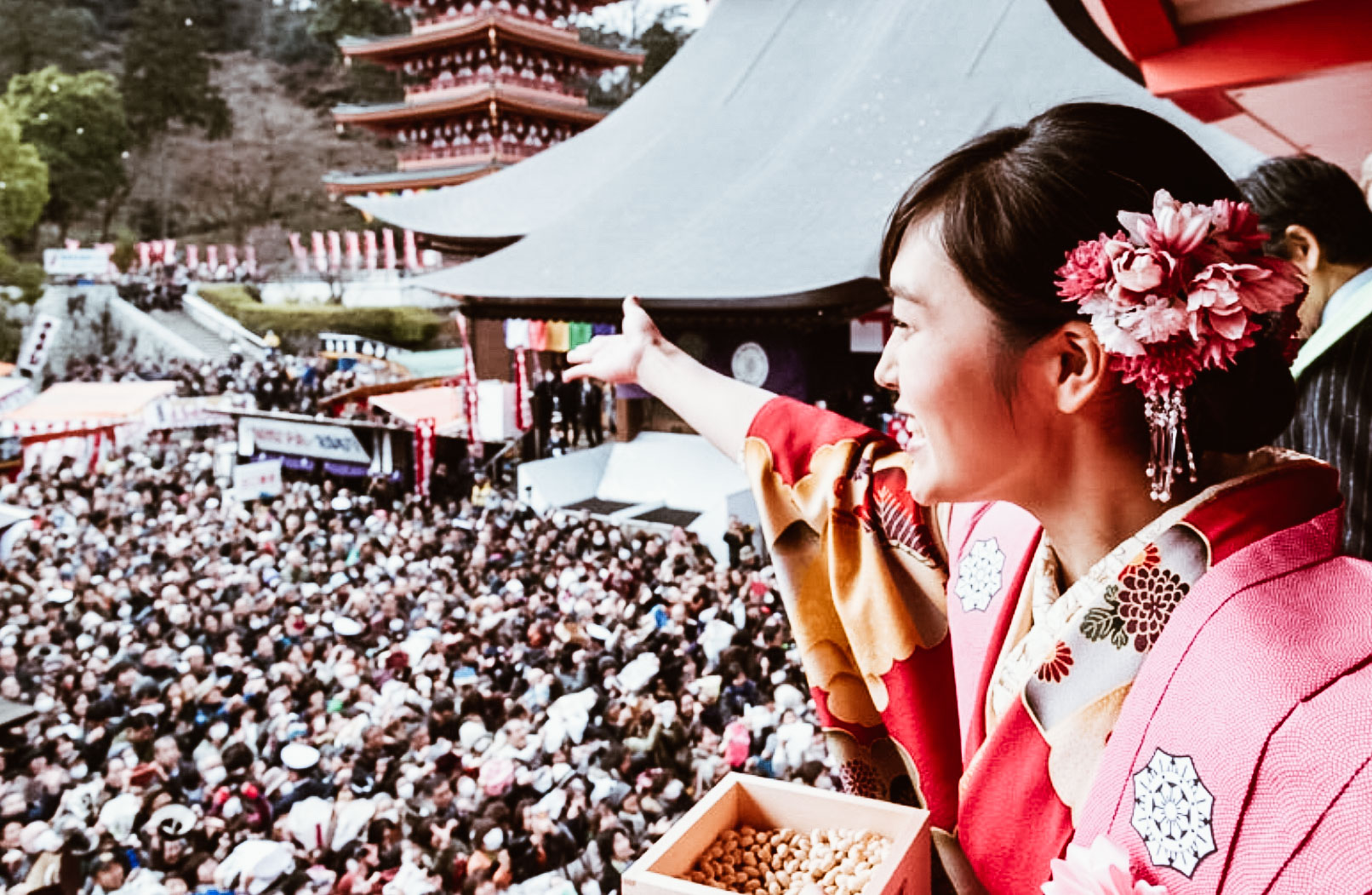Japan Folklore: Setsubun, come scacciare i demoni dell’inverno per accogliere la primavera

photo credits: pinterest.it
La cultura tradizionale giapponese è sempre stata caratterizzata da una costante ed amorevole osservazione del mondo naturale, delle sue manifestazioni e dei suoi cicli stagionali. Non deve quindi meravigliare l’attenzione riservata alla primavera, lo speciale momento in cui la natura risveglia in tutte le sue creature la necessità del rinnovamento.
Questa stagione è celebrata in Giappone con l’haru matsuri (春祭, festival di primavera), un insieme di eventi il cui inizio è segnato dalla ricorrenza di Setsubun (節分). Nel tradizionale calendario lunisolare giapponese, infatti, ogni cambio di stagione è introdotto da un giorno chiamato, appunto, setsubun (letteralmente “divisione delle stagioni”). Il setsubun di primavera, che cade il 3 febbraio, rappresenta l’ultimo giorno dell’inverno e il giorno che precede l’inizio della nuova stagione. Segna quindi il passaggio dal “Taikan” (大寒, grande freddo) al “Risshun” (立春, primo giorno di primavera) ed è perciò il momento più propizio per una speciale “pulizia” dai fardelli invernali, che allontanerà gli spiriti maligni e favorirà l’ingresso della nuova energia vivificante. E’ questo il senso della tradizionale “cacciata dei demoni” che ha luogo in questo giorno attraverso diversi riti ed usanze.

photo credits: pinimg.com
Antichi rituali e divertimento per famiglie
Il rituale più famoso è senza dubbio il mamemaki (豆撒き), ovvero il lancio dei fagioli di soia. In ambito domestico esso è affidato al Toshi Otoko (年男, uomo dell’anno), cioè l’uomo della famiglia del segno zodiacale dell’anno lunare entrante o in sua assenza il più anziano di casa; costui ha il compito di scacciare gli spiriti nocivi e le negatività dalla casa e dal nuovo periodo dell’anno che sta per iniziare lanciando in giro irimame (炒り豆, fagioli di soia tostati) al grido di “Oni wa soto! fuku wa uchi! (鬼は外! 福は内, “Fuori i demoni! Dentro la fortuna!”). In alternativa si possono scagliare gli irimame contro un altro membro della famiglia che interpreta la parte del demone indossando una maschera da oni (orchi del folcklore giapponese). Successivamente ogni componente della famiglia deve raccogliere e mangiare un numero di fagioli corrispondente alla propria età più uno per assicurarsi un anno di successi e buona salute (nella tradizione popolare, infatti, i demoni sono ritenuti portatori di catastrofi naturali e malattie). Scacciato l’oni, è però necessario tenere gli spiriti maligni lontani dalla casa. Per questo è possibile vedere in questo periodo dell’anno dei particolarissimi amuleti, gli Hiiragi Iwashi (柊鰯), esposti all’ingresso delle abitazioni. Si tratta di rami di agrifoglio che presentano la testa di una sardina essiccata infilzata sull’estremità, talvolta completati da pezzi di aglio o cipolla, che hanno appunto lo scopo di tenere lontani i demoni, timorosi delle spine e dell’ odore pungente emanato da questi talismani.
Si tratta in entrambi i casi di tradizioni che affondano le proprie radici nell’antichità. Al giorno d’oggi è possibile acquistare “set da Setsubun” – composti da maschere da oni e fagioli tostati – in qualsiasi conbini, ma in realtà l’usanza del mamemaki avrebbe avuto origine nel periodo Muromachi (1392-1573) e sembra essere ispirata ad un’antichissima leggenda, la cui trama viene tuttora rappresentata in forma di pantomima nel tempio di Mibu-dera a Kyoto. Qui il kyogen (antica forma teatrale giapponese) intitolato “Setsubun” viene replicato più volte nel corso della giornata e si dice che basti assistere ad esso per essere purificati da ogni spirito negativo o malvagio. La sua trama ricalca il racconto folkloristico che narra di un orco il quale, sotto sembianze umane, si reca un giorno a far visita ad una vedova. Grazie al suo martello magico, l’orco confeziona un bellissimo kimono, che attira l’attenzione della vedova. Desiderosa di impossessarsi non solo del kimono ma anche del martello magico, essa decide di farlo ubriacare per poterglieli rubare entrambi. L’orco, però, accortosi del furto, rivela la propria natura demoniaca ed attacca la donna, che per difendersi gli scaglia contro la prima cosa che trova a portata di mano: un pugno di fagioli di soia. L’oni, ferito ma di nuovo in possesso dei suoi beni, fugge lasciando la vedova sana e salva e forse un po’ più saggia.

photo credits: toyokeizai.net
Saper guardare nella giusta direzione
Un’usanza di origini più recenti, nata ad Osaka ma successivamente diffusasi nel resto del paese, è invece quella legata all’ehōmaki (恵方巻, rotolo della direzione fortunata). In questo caso, per assicurarsi che la buona sorte sia al nostro fianco nell’anno che sta per iniziare, è necessario mangiare uno speciale rotolo di sushi in un’unica soluzione, senza interruzioni ed in silenzio, rivolti nella direzione fortunata dell’anno. L’impresa è meno semplice di quel che può sembrare, considerando che l’ehōmaki è molto più spesso di un comune sushi roll (dovendo contenere sette ingredienti per propiziarsi i sette dei della fortuna) ed è lungo 20 centimetri. Non vale mangiarlo tagliato in pezzi, perché così facendo si taglierebbe anche la fortuna. Per compiere correttamente il rituale è necessario quindi armarsi di concentrazione, determinazione e di una bussola precisa. Per chi fosse interessato a sperimentare questa usanza, gli ingredienti più comuni da procurarsi per la farcitura sono cetriolo, surimi, salmone, tonno, anago (anguilla di mare), tamagoyaki (omelette giapponese), strisce di kanpyo essiccate e condite (zucca giapponese) e funghi shiitake, oltre naturalmente al riso e all’alga nori, mentre la direzione fortunata per il 2019 è Est-NordEst.

photo credits: shinsenhino.com
Templi in festa
Il Setsubun può essere celebrato in un ambiente domestico o comunque in una dimensione privata, con parenti ed amici, ma è anche e soprattutto una ricorrenza da vivere in comunità. Ad esempio nelle scuole vengono spesso organizzati momenti di ricreazione per i bambini, che indossano maschere da oni o si divertono a dare la caccia ad adulti travestiti da demoni, rincorrendoli e scagliando loro fagioli. Ma è in particolare nei templi che è possibile vivere la dimensione collettiva della festa, partecipando agli eventi appositamente realizzati per questa giornata. Primo fra tutti naturalmente il mamemaki, effettuato dai monaci che dall’alto di appositi palchi lanciano fagioli di soia sulla folla radunata per l’evento. In alcuni templi vengono organizzati più turni per questo rituale, riservandone alcuni speciali ai bambini, che oltre ai fagioli ricevono dolci o piccoli doni. Oltre ai monaci sono spesso presenti personaggi celebri, come campioni sportivi, protagonisti del mondo dello spettacolo, attori del teatro kabuki, geisha e maiko, celebrità televisive, che aggiungono una nota di attrattiva glamour ai festeggiamenti tradizionali. Tra questi ultimi vanno ricordati gli spettacoli teatrali, le diverse cerimonie di purificazione o anche le suggestive esibizioni di tiro con l’arco, in cui gli arcieri scagliano le proprie frecce contro bersagli che hanno fattezze di demoni.
Setsubun è insomma la giornata ideale per coloro che desiderano vivere in compagnia un inizio d’anno che aiuti a rinnovare le proprie energie e per le famiglie che hanno l’opportunità di trascorrere insieme un momento di allegria, cosa che ad ogni latitudine resta sempre il miglior talismano contro ogni male.
Condividi:
- Fai clic per condividere su Facebook (Si apre in una nuova finestra)
- Fai clic qui per condividere su Twitter (Si apre in una nuova finestra)
- Fai clic qui per condividere su Tumblr (Si apre in una nuova finestra)
- Fai clic qui per condividere su Pinterest (Si apre in una nuova finestra)
- Fai clic per condividere su Telegram (Si apre in una nuova finestra)
- Fai clic per condividere su WhatsApp (Si apre in una nuova finestra)
- Fai clic qui per condividere su Reddit (Si apre in una nuova finestra)
- Fai clic qui per stampare (Si apre in una nuova finestra)






